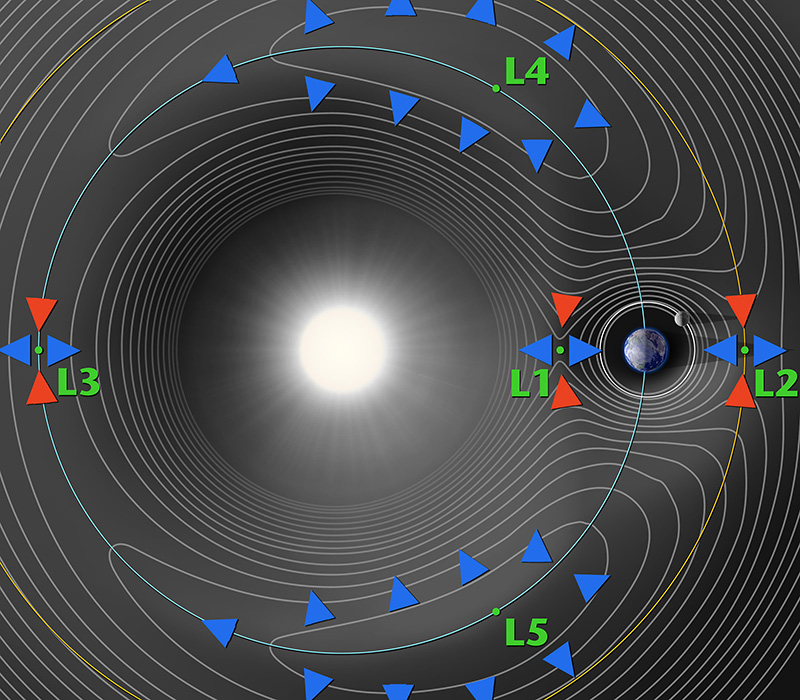Lagrange, << lah grahnzh >> , point is a special location near two astronomical bodies orbiting each other. At a Lagrange point, also called a Lagrangian point, the influences exerted by the bodies’ motion and by their gravitational pulls all balance one another. A smaller object, such as a space probe, can often remain at a Lagrange point using little or no energy. Lagrange points are named for Joseph-Louis Lagrange, the French mathematician who discovered their existence.

Two orbiting bodies, such as Earth and the sun, actually revolve around their common center of mass. Mass is the amount of matter an object contains. The common center of mass is the point between the two bodies where their combined mass balances.
You can imagine an orbiting two-body system, such as Earth and the sun, as a merry-go-round spinning around the common center of mass. If you could stand on this merry-go-round, you would feel different influences. The sun’s gravitation would pull you toward the sun, and Earth’s gravitation would pull you toward Earth. Your body’s inertia (tendency to maintain its state of motion) would feel like a third force pulling you away from the common center of mass. At five different spots on the merry-go-round—the Earth-sun Lagrange points—these three influences would balance. Standing at a Lagrange point, you would not feel an overall pull in any direction.
All orbiting two-body systems have five Lagrange points. Mathematicians label these points L1, L2, L3, L4, and L5. The points L1, L2, and L3 all lie along a line connecting the bodies. The L1 point lies between the bodies. The L2 point lies beyond the less massive body, and the L3 point lies beyond the more massive body. If an object at the L1, L2, or L3 point drifts even slightly away, the influences of gravity and inertia will tend to pull it farther from the point. For this reason, mathematicians sometimes call these points the unstable Lagrange points. The Swiss mathematician Leonhard Euler discovered the unstable Lagrange points.
The points L4 and L5 each lie at a vertex (corner) of an imaginary equilateral triangle, a triangle with three equal sides. The triangle’s other vertexes are the two orbiting bodies. The L4 and L5 points are stable—that is, if an object at one of these points begins to drift, inertia and gravitation will tend to pull the object back to the point.
Spacecraft can take advantage of Lagrange points to conserve fuel. The Earth-sun L1 and L2 points lie relatively near Earth. Spacecraft can travel to and remain near them using relatively little energy. For example, the U.S. probe Genesis, launched in 2001, collected particles given off by the sun while stationed at the Earth-sun L1 point. The U.S. Wilkinson Microwave Anisotropy Probe, also launched in 2001, measured cosmic radiation from its position at the Earth-sun L2 point. The Japanese Hiten spacecraft, launched in 1990, and the European SMART-1 probe, launched in 2003, used complex maneuvers near the Earth-sun and Earth-moon L1 and L2 points to reach the moon using almost no fuel.
Because the L4 and L5 points are stable, natural objects can become trapped in these areas. The Trojan asteroids, for example, are two famous groups of asteroids gathered near the L4 and L5 points of the Jupiter-sun system.
See also Star (Binary stars)
